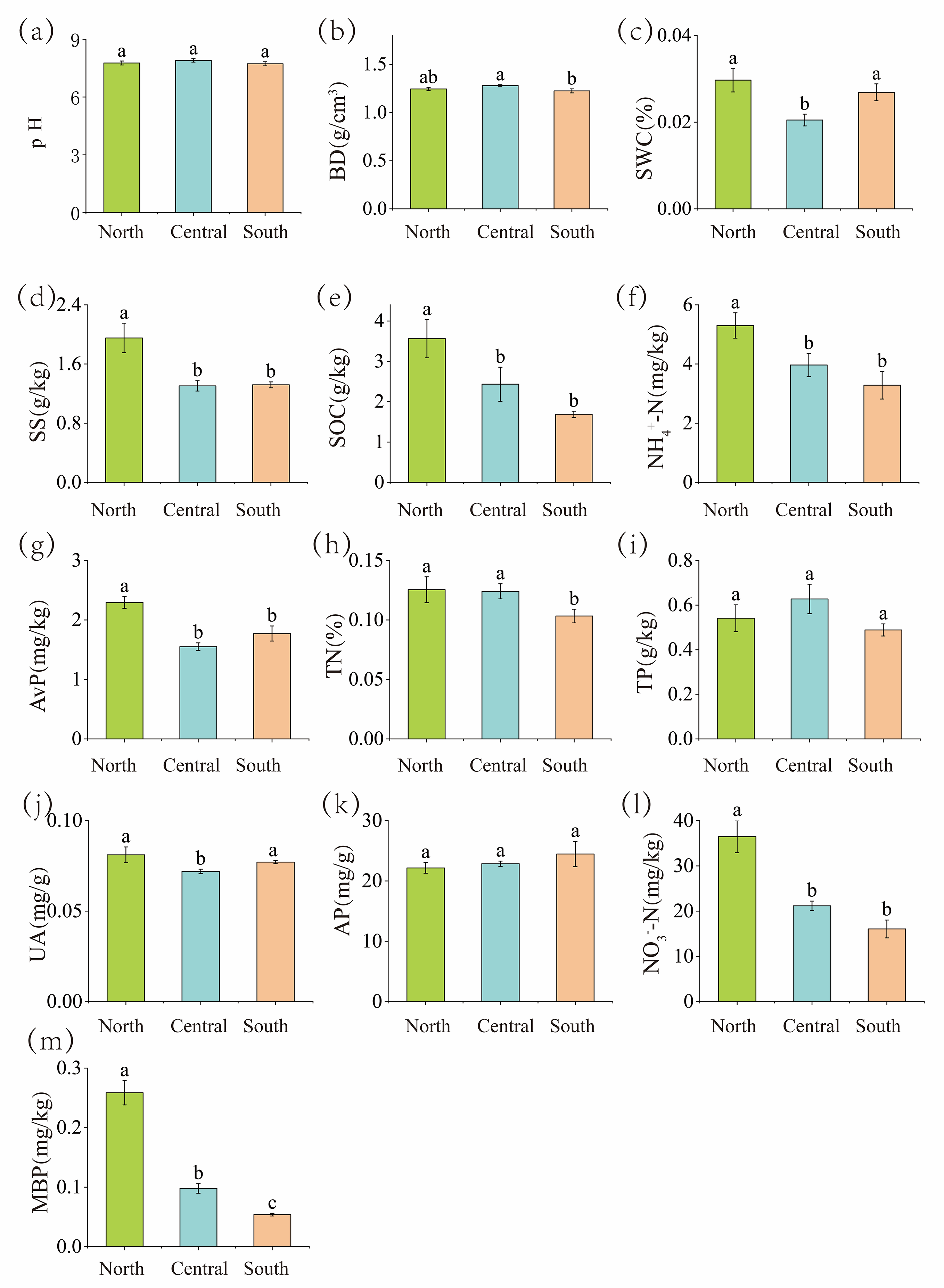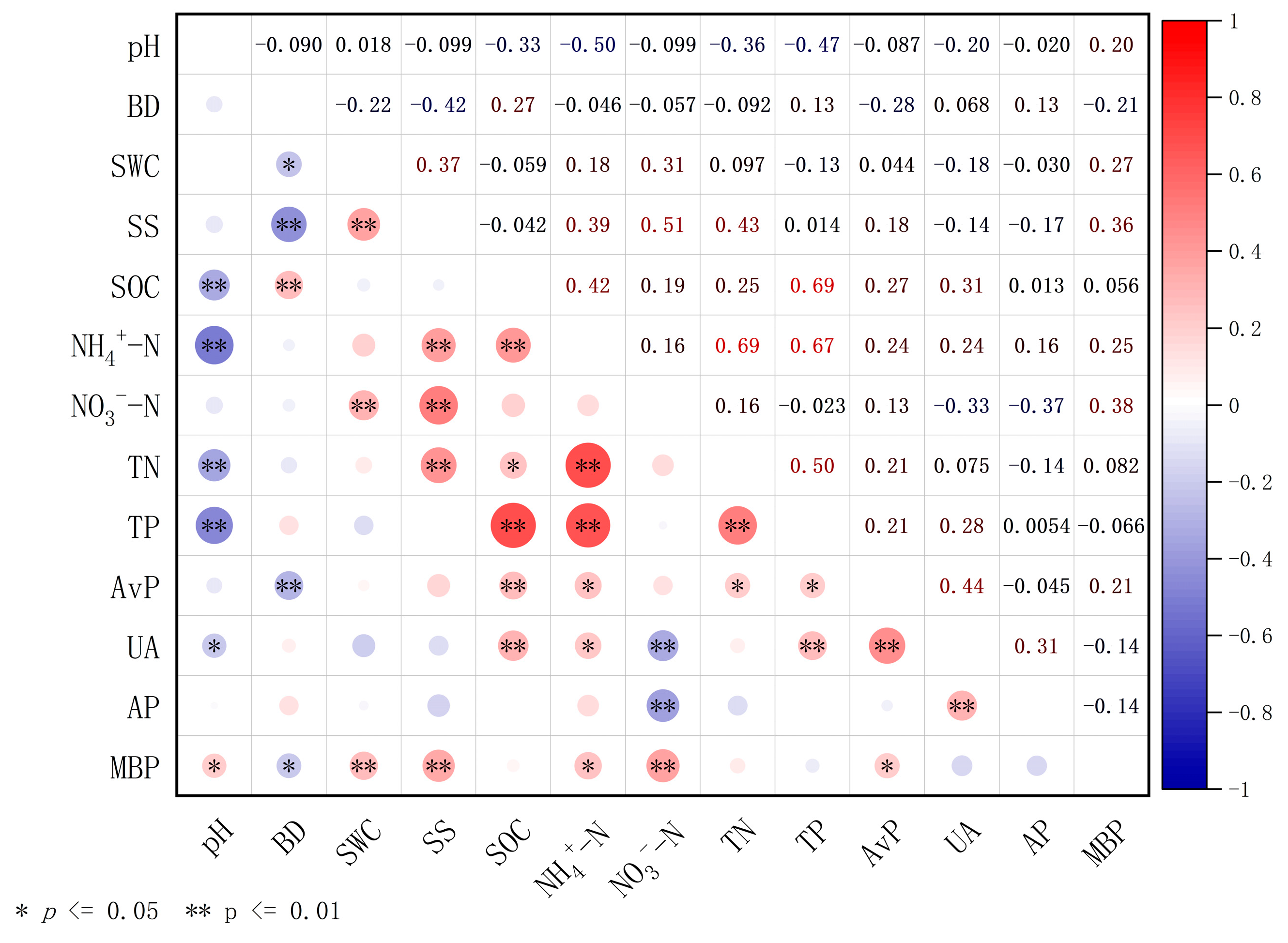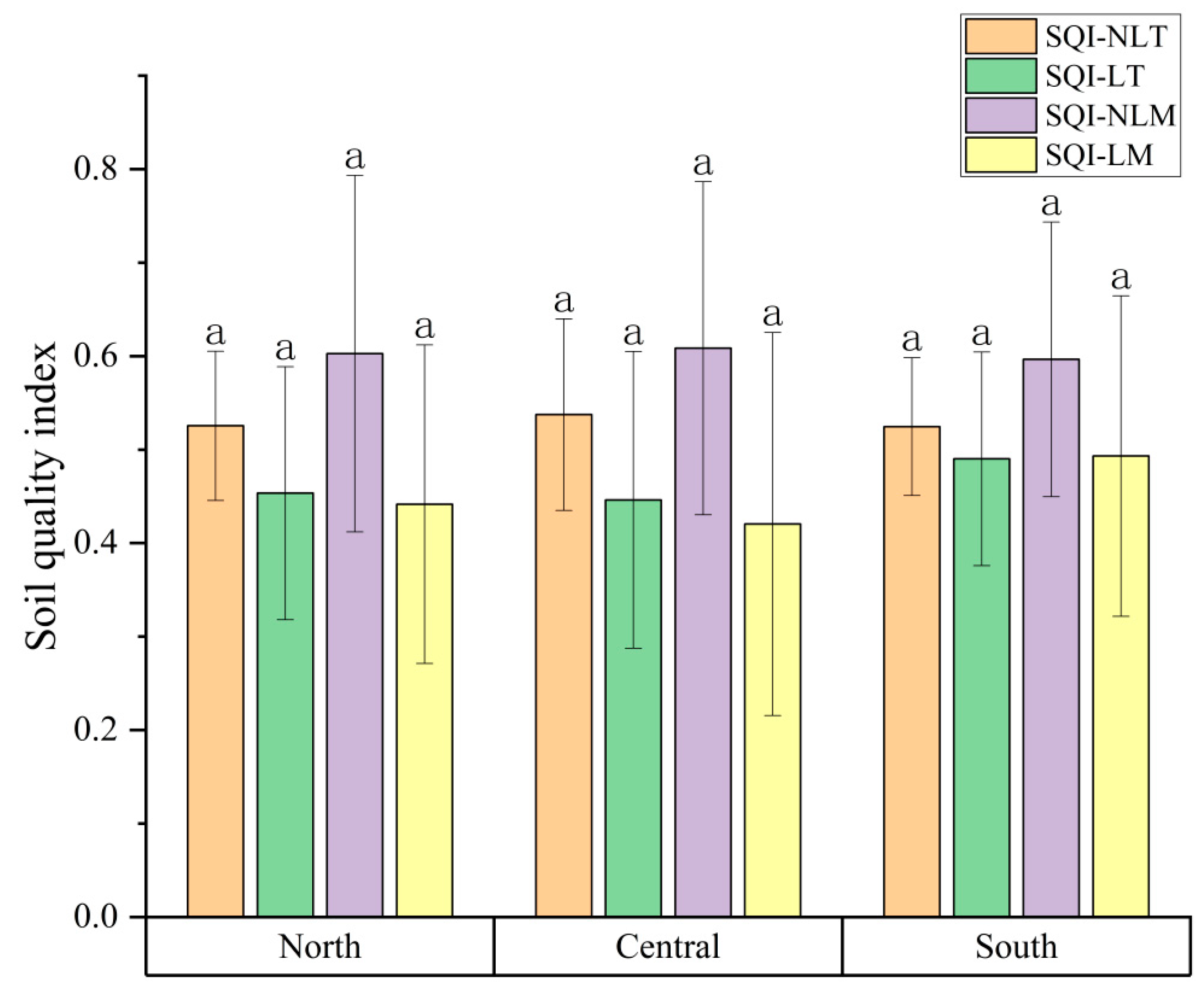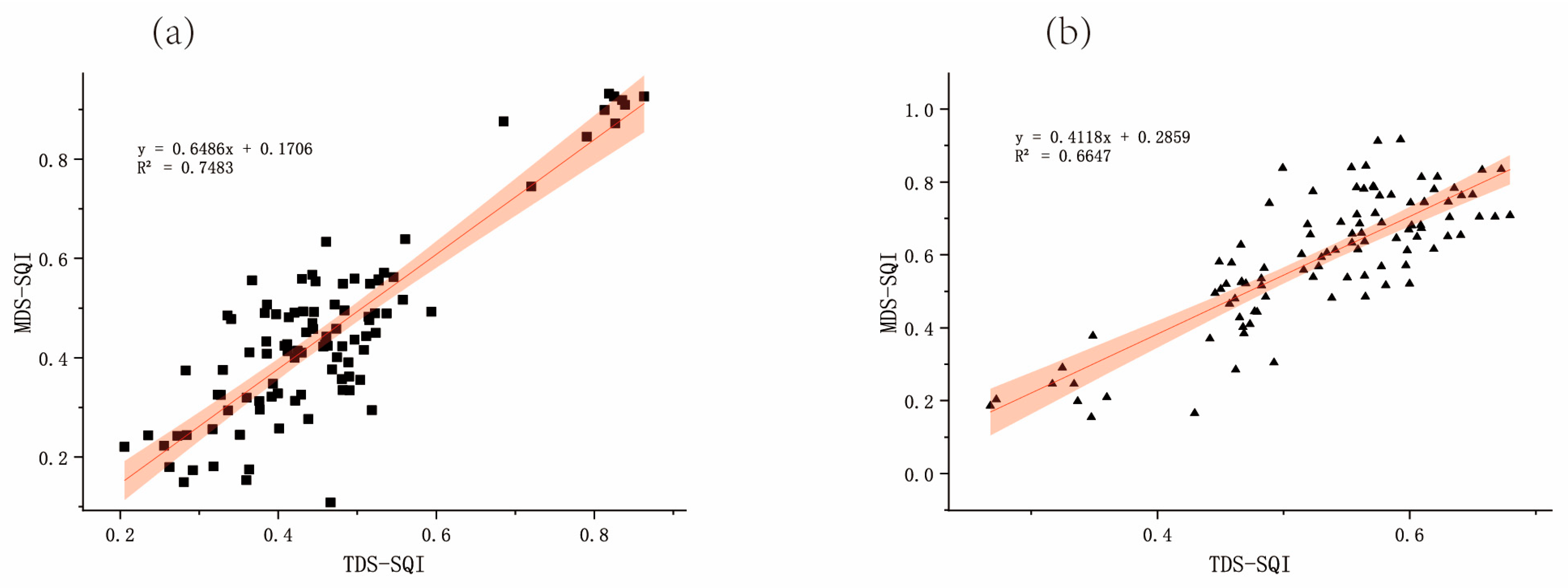Evaluation of Soil Quality and Analysis of Barriers of Protection Forests along Tarim Desert Highway Based on a Minimum Data Set
Abstract
:1. Introduction
2. Materials and Methods
2.1. Overview of the Study Area
2.2. Sample Site Layout and Sample Collection
2.3. Methodology for Testing and Analyzing Indicators
2.4. Soil Quality Assessment Methods
2.4.1. Construction of Minimum Data Set for Soil Quality Evaluation
2.4.2. Soil Quality Evaluation Index
2.5. Diagnosis of Soil Barrier Factors
2.6. Data Processing
3. Results
3.1. Statistical Characteristics of Soil Physical and Chemical Properties and Biological Indicators
3.2. Minimum Dataset for Soil Quality Evaluation
3.3. Evaluation of Soil Quality Based on Two Scoring Models
3.4. Analysis of Soil Quality Barriers
4. Discussion
5. Conclusions
Supplementary Materials
Author Contributions
Funding
Institutional Review Board Statement
Informed Consent Statement
Data Availability Statement
Conflicts of Interest
References
- Fan, B.L. Natural Regeneration Strategies of Calligonum mongolicum under Different Aeolian Environments. Ph.D. Thesis, Lanzhou University, Lanzhou, China, 2017. [Google Scholar]
- Han, J.; Liu, Y.; Zhang, Y. Sand stabilization effect of feldspathic sandstone during the fallow period in Mu Us Sandy Land. J. Geogr. Sci. 2015, 25, 428–436. [Google Scholar] [CrossRef]
- Cheng, K.; Su, Y.; Guan, H.; Tao, S.; Ren, Y.; Hu, T.; Ma, K.; Tang, Y.; Guo, Q. Mapping China’s planted forests using high resolution imagery and massive amounts of crowdsourced samples. ISPRS J. Photogramm. Remote Sens. 2023, 196, 356–371. [Google Scholar] [CrossRef]
- Zhu, J.; Dai, E.; Zheng, D.; Wang, X. Characteristic of tradeoffs between timber production and carbon storage for plantation under harvesting impact: A case study of Huitong National Research Station of Forest Ecosystem. Acta Geogr. Sin. 2018, 73, 152–163. [Google Scholar] [CrossRef]
- Doran, J.W.; Parkin, T.B. Defining and Assessing Soil Quality. In Defining Soil Quality for a Sustainable Environment; Wiley Online Library: Hoboken, NJ, USA, 1994; pp. 1–21. [Google Scholar]
- Bunemann, E.K.; Bongiorno, G.; Bai, Z.; Creamer, R.E.; De Deyn, G.; de Goede, R.; Fleskens, L.; Geissen, V.; Kuyper, T.W.; Mader, P.; et al. Soil quality—A critical review. Soil Biol. Biochem. 2018, 120, 105–125. [Google Scholar] [CrossRef]
- Jose Sione, S.M.; German Wilson, M.; Lado, M.; Paz Gonzalez, A. Evaluation of soil degradation produced by rice crop systems in a Vertisol, using a soil quality index. Catena 2017, 150, 79–86. [Google Scholar] [CrossRef]
- Shao, G.; Ai, J.; Sun, Q.; Hou, L.; Dong, Y. Soil quality assessment under different forest types in the Mount Tai, central Eastern China. Ecol. Indic. 2020, 115, 106439. [Google Scholar] [CrossRef]
- Liu, J.; Wu, L.C.; Chen, D.; Yu, Z.G.; Wei, C.J. Development of a soil quality index for Camellia oleifera forestland yield under three different parent materials in Southern China. Soil Tillage Res. 2018, 176, 45–50. [Google Scholar] [CrossRef]
- Memoli, V.; De Marco, A.; Esposito, F.; Panico, S.C.; Barile, R.; Maisto, G. Seasonality, altitude and human activities control soil quality in a national park surrounded by an urban area. Geoderma 2019, 337, 1–10. [Google Scholar] [CrossRef]
- Yu, P.; Liu, S.; Zhang, L.; Li, Q.; Zhou, D. Selecting the minimum data set and quantitative soil quality indexing of alkaline soils under different land uses in northeastern China. Sci. Total Environ. 2018, 616, 564–571. [Google Scholar] [CrossRef] [PubMed]
- Zhang, C.; Xue, S.; Liu, G.-B.; Song, Z.-L. A comparison of soil qualities of different revegetation types in the Loess Plateau, China. Plant Soil 2011, 347, 163–178. [Google Scholar] [CrossRef]
- Raiesi, F. A minimum data set and soil quality index to quantify the effect of land use conversion on soil quality and degradation in native rangelands of upland arid and semiarid regions. Ecol. Indic. 2017, 75, 307–320. [Google Scholar] [CrossRef]
- Wang, S.; Luo, Z.; Niu, Y.; Cai, L.; Liu, J.; Li, L. Soil Quality Evaluation of Alfalfa Fields in Semi-arid Areas of the Loess Plateau Based on Minimum Data Set. Chin. J. Grassl. 2023, 45, 81–90. [Google Scholar]
- Gong, L.; Zhang, X.; Ran, Q. Quality assessment of oasis soil in the upper reaches of Tarim River based on minimum data set. Acta Pedol. Sin. 2015, 52, 682–689. [Google Scholar]
- Rahmanipour, F.; Marzaioli, R.; Bahrami, H.A.; Fereidouni, Z.; Bandarabadi, S.R. Assessment of soil quality indices in agricultural lands of Qazvin Province, Iran. Ecol. Indic. 2014, 40, 19–26. [Google Scholar] [CrossRef]
- Marzaioli, R.; D’Ascoli, R.; De Pascale, R.A.; Rutigliano, F.A. Soil quality in a Mediterranean area of Southern Italy as related to different land use types. Appl. Soil Ecol. 2010, 44, 205–212. [Google Scholar] [CrossRef]
- Burns, R.G.; Nannipieri, P.; Benedetti, A.; Hopkins, D.W. Defining Soil Quality; CABI Publishing: Wallingford, UK, 2009; pp. 15–22. [Google Scholar]
- Wu, S.; Peng, H. Soil in Xinjiang; Science Publishing House: Beijing, China, 1996. [Google Scholar]
- Zhou, Z.; Xu, X. Distribution Characteristics of Soil enzymes of Talimu Desert Highway Shelter-Forest and Their Relations with Soil Organic Matter. J. Soil Water Conserv. 2004, 18, 10–14. [Google Scholar]
- Guan, S. (Ed.) Research Methods of Soil Enzyme; China Agriculture Press: Beijing, China, 1986; pp. 206–239. (In Chinese) [Google Scholar]
- Lu, R. (Ed.) Analytical Methods f or Soil and Agro-Chemistry; China Agricultural Science and Technology Press: Beijing, China, 2000. [Google Scholar]
- Wang, F.; Li, Q.-H.; Lin, C.; He, C.-M.; Zhong, S.-J.; Li, Y.; Lin, X.-J. Establishing a minimum data set of soil quality assessment for cold-waterlogged paddy field in Fujian Province, China. Yingyong Shengtai Xuebao 2015, 26, 1461–1468. [Google Scholar] [PubMed]
- Chen, Y.-D.; Wang, H.-Y.; Zhou, J.-M.; Xing, L.; Zhu, B.-S.; Zhao, Y.-C.; Chen, X.-Q. Minimum Data Set for Assessing Soil Quality in Farmland of Northeast China. Pedosphere 2013, 23, 564–576. [Google Scholar] [CrossRef]
- Govaerts, B.; Sayre, K.D.; Deckers, J. A minimum data set for soil quality assessment of wheat and maize cropping in the highlands of Mexico. Soil Tillage Res. 2006, 87, 163–174. [Google Scholar] [CrossRef]
- Zhang, G.; Bai, J.; Xi, M.; Zhao, Q.; Lu, Q.; Jia, J. Soil quality assessment of coastal wetlands in the Yellow River Delta of China based on the minimum data set. Ecol. Indic. 2016, 66, 458–466. [Google Scholar] [CrossRef]
- Cui, X.; Wang, H.; Zou, J.; Du, X.; Meng, H. Soil Quality Assessment of Natural Coniferous and Broad-leaved Mixed Forest under Different Cutting Intensities Using Minimum Data Set. J. North-East For. Univ. 2022, 50, 88–94. [Google Scholar]
- Qian, F.; Yu, Y.; Dong, X.; Gu, H. Soil Quality Evaluation Based on a Minimum Data Set (MDS)-A Case Study of Tieling County, Northeast China. Land 2023, 12, 1263. [Google Scholar] [CrossRef]
- Xue, Y.J.; Liu, S.G.; Hu, Y.M.; Yang, J.F. Soil Quality Assessment Using Weighted Fuzzy Association Rules. Pedosphere 2010, 20, 334–341. [Google Scholar] [CrossRef]
- Huang, M.; Lu, R.; Zhao, J.; Ma, L. Assessment of soil quality in typical wind erosion area of Qaidam Basin. J. Desert Res. 2023, 43, 199–209. [Google Scholar]
- He, Y.; Mo, Y.; Ma, J. Spatio-Temporal Evolution and Influence Mechanism of Habitat Quality in Guilin City, China. Int. J. Environ. Res. Public Health 2023, 20, 748. [Google Scholar] [CrossRef] [PubMed]
- Andrews, S.S.; Karlen, D.L.; Mitchell, J.P. A comparison of soil quality indexing methods for vegetable production systems in Northern California. Agric. Ecosyst. Environ. 2002, 90, 25–45. [Google Scholar] [CrossRef]
- Niemeyer, J.C.; Lolata, G.B.; de Carvalho, G.M.; Da Silva, E.M.; Sousa, J.P.; Nogueira, M.A. Microbial indicators of soil health as tools for ecological risk assessment of a metal contaminated site in Brazil. Appl. Soil Ecol. 2012, 59, 96–105. [Google Scholar] [CrossRef]
- Guo, L.; Sun, Z.; Ouyang, Z.; Han, D.; Li, F. A comparison of soil quality evaluation methods for Fluvisol along the lower Yellow River. Catena 2017, 152, 135–143. [Google Scholar] [CrossRef]
- Wang, F.; Li, W.; Chen, H.; Weil, R.R.; Zhu, L.; Nan, X. Forage Radish Cover Crops Improve Soil Quality and Fruit Yield of Lycium barbarum L. in an Arid Area of Northwest China. Agronomy 2023, 13, 1634. [Google Scholar] [CrossRef]
- Li, W.; Zhang, J.; Song, S.; Liang, Y.; Sun, B.; Wu, Y.; Mao, X.; Lin, Y. Combination of artificial zeolite and microbial fertilizer to improve mining soils in an arid area of Inner Mongolia, China. J. Arid Land 2023, 15, 1067–1083. [Google Scholar] [CrossRef]
- Ye, Z.Z.; Wang, Y.S.; Lu, X.; Shi, D.P.; Qiang, L.S.; Li, J.; Yang, Z.Y.; Wang, L.Q. Effects of Straw Retention, Film Mulching, and Nitrogen Input on Soil Quality in Dryland Wheat Field. Environ. Sci. 2024, 1–18. [Google Scholar] [CrossRef]
- Dai, Z.j. Effects of Conservation Tillage on Soil Hydrothermal Conditions and Carbon and Nitrogen Conversion in Weibei Arid Plateau. Ph.D. Thesis, Northwest A&F University, Yangling, China, 2023. [Google Scholar]
- Li, X.; Li, Y.; Xie, T.; Chang, Z.; Li, X. Recovery of soil carbon and nitrogen stocks following afforestation with xerophytic shrubs in the Tengger Desert, North China. Catena 2022, 214, 106277. [Google Scholar] [CrossRef]
- Erkin, F.; Yue, D.; Abdureyim, A.; Huang, W.; Tayir, M. Link between the aboveground and belowground biomass allocation with growing of Tamarix sp. seedlings in the hinterland of Taklimakan Desert, China. PLoS ONE 2023, 18, e0289670. [Google Scholar] [CrossRef] [PubMed]
- Alzhan, K.; Xue, W.; Li, X.; Zeng, F.; Rapkat, S.; Tohtirijap, T. High biomass production with abundant leaf litterfall is critical to ameliorating soil quality and productivity in reclaimed sandy desertification land. J. Environ. Manag. 2020, 263, 110373. [Google Scholar]
- Zhang, L.X.; Duan, Y.X.; Wang, B.; Wang, W.F.; Li, X.J.; Liu, J.J. Characteristics of soil microorganisms and soil nutrients in different sand-fixation shrub plantations in Kubuqi Desert, China. Ying Yong Sheng Tai Xue Bao = J. Appl. Ecol. 2017, 28, 3871–3880. [Google Scholar]
- Jin, Z.; Lei, J.; Li, S.; Xu, X.; Qiu, Y.; Gu, F.; Liu, X. Vertical Variation and Evaluation of Soil Fertility Quality of Windbreak Forest Soil in the Hinterland of Rolling Desert. Acta Pedol. Sin. 2010, 47, 1075–1085. [Google Scholar]
- Wang, Y.; Jin, Z.; Lei, J.; Wang, Y.; Fu, Q. Effects of Artificial Shelter Forest on Dynamic Change of Organic Carbon Pool of Aeolian Sandy Soil. Arid Zone Res. 2017, 34, 495–503. [Google Scholar]
- Jin, Z.-Z.; Lei, J.-Q.; Xu, X.-W.; Li, S.-Y.; Fan, J.-L.; Zhao, S.-F.; Zhou, H.-W.; Gu, F. Relationships of soil microbial biomass with soil environmental factors in Tarim Desert highway shelter-forest. Ying Yong Sheng Tai Xue Bao = J. Appl. Ecol. 2009, 20, 51–57. [Google Scholar]
- Dong, Z.; Li, C.; Li, S.; Lei, J.; Zhao, Y.; Umut, H. Stoichiometric features of C, N, and P in soil and litter of Tamarix cones and their relationship with environmental factors in the Taklimakan Desert, China. J. Soils Sediments 2020, 20, 690–704. [Google Scholar] [CrossRef]
- Fan, J.; Wei, Y.; Xu, X.; Yang, X. Effect of drip irrigation with saline water on the construction of shelterbelts for soil and groundwater protection in the hinterland of the Taklimakan Desert, China. Tecnol. Y Cienc. Del Agua 2017, 8, 19–30. [Google Scholar] [CrossRef]
- Jin, Z.; Lei, J.; Li, S.; Xu, X. Biochemical intensity and microbial eco-characterization of soils irrigated with saline water from the Tarim Desert Highway shelter-belt. Acta Ecol. Sin. 2017, 37, 4091–4099. [Google Scholar]
- Wei, Y.F.; Guo, K.; Chen, J.Q. Effect of precipitation pattern on recruitment of soil water in kubuqi desert, northwestern China. Acta Phytoecol. Sin. 2008, 32, 1346–1355. [Google Scholar]
- Liu, J.; Gao, Q.; Guo, K.; Liu, X.; Shao, Z.; Zhang, Z. Actual Evaporation of Bare Sand Dunes in Maowusu, Response to Precipitation Pattern. Acta Phytoecol. Sin. 2008, 32, 123–132. [Google Scholar]
- Gao, H.Y.; Yang, Z.G.; Zhang, S.G.; Huang, H.G.; Yan, D.R. Effects of stand age on soil enzyme activity and chemical properties of Pinus tabulaeformis plantation in Horqin sandy land. J. Cent. South Univ. For. Technol. 2024, 44, 108–117. [Google Scholar] [CrossRef]
- Lang, M.; Zhang, R.; Han, H.; Wang, X.; Fan, S. Effects of Pinus sylvestris var. mongolica Plantation on Soil Water and Salt in the Southern Edge of Horqin Sandy Land. J. Soil Water Conserv. 2023, 37, 370–376. [Google Scholar]
- Chen, Y.; Zhang, F.; Gao, G.; Ding, G.; Zhang, Y.; Liu, X. Soil particle size distribution of Pinus sylvestris var. mongolica plantations in the Horqin Sandy Land. Arid Land Geogr. 2020, 43, 1051–1058. [Google Scholar]
- Feng, W.; Jiang, J.; Lin, L.; Wang, Y. Soil calcium prompts organic carbon accumulation after decadal saline-water irrigation in the Taklamakan desert. J. Environ. Manag. 2023, 344, 118421. [Google Scholar] [CrossRef] [PubMed]
- Foote, J.A.; Boutton, T.W.; Scott, D.A. Soil C and N storage and microbial biomass in US southern pine forests: Influence of forest management. For. Ecol. Manag. 2015, 355, 48–57. [Google Scholar] [CrossRef]
- Tian, Y.; Xu, Z.; Wang, Y.; He, J.; Wang, Z. Soil quality evaluation for different forest plantation of sandy land in Yinchuan Plain, Ningxia. Acta Ecol. Sin. 2023, 43, 1515–1525. [Google Scholar]
- Li, P.; Qi, S.; Zhang, L.; Hu, J.; Tang, Y.; Lu, J.S.; Wang, X.Y.; Lai, J.L.; Liao, R.E.; Zhang, D.; et al. Comprehensive Evaluation of Soil Quality of Different Vegetation Restoration Types in Mountainous Areas of Beijing. J. Soil Water Conserv. 2024, 38, 337–346. [Google Scholar] [CrossRef]
- Qiao, Y.; Zhong, X.; Miao, S.; Li, Q.; Lu, X. Evaluation Indicators of Soil Quality in Plough Layer of Aeolian Sandy Land in Northeast China Based on Minimum Data Set. Res. Soil Water Conserv. 2019, 26, 132–138. [Google Scholar]
- Zhu, Z.Y.; Wu, L.C. Fertilization and Residue Management Improved Soil Quality of Eucalyptus Plantations. Forests 2023, 14, 1570. [Google Scholar] [CrossRef]
- Chen, M. Evaluation of Soil Quality and Analysis of Obstacle Factors in Saline-Alkali Land in the Yellow River Delta—A Case Study of the Agricultural High-Tech Industry Demonstration Area of the Yellow River. Master’s Thesis, Ludong University, Yantai, China, 2023. [Google Scholar]
- Marhaba, N.; Bilal, E.; Shi, Q.; Dai, Y.; Shi, H.; Xiao, H.B. Water sources of Tamarix sp. seedlings at the Daryaboyi oasis in the hinterland of desert. J. Arid Land Resour. Environ. 2021, 35, 159–166. [Google Scholar]
- Yang, X.; Wang, M.; He, Q.; Mamtimin, A.; Huo, W.; Yang, F.; Zhou, C. Estimation of sampling efficiency of the Big Spring Number Eight (BSNE) sampler at different heights based on sand particle size in the Taklimakan Desert. Geomorphology 2018, 322, 89–96. [Google Scholar] [CrossRef]
- He, Q.; Yang, X.; Ali, M.; Liu, X. Impact factors of soil wind erosion in Tazhong Area. Arid Land Geogr. 2010, 33, 502–508. [Google Scholar]
- Tariq, A.; Graciano, C.; Sardans, J.; Ullah, A.; Zeng, F.; Ullah, I.; Ahmed, Z.; Ali, S.; Al-Bakre, D.A.; Zhang, Z.; et al. Decade-long unsustainable vegetation management practices increase macronutrient losses from the plant-soil system in the Taklamakan Desert. Ecol. Indic. 2022, 145, 109653. [Google Scholar] [CrossRef]
- Tang, M.; Zhang, F.; Shi, Q. Variations in groundwater table depth at Daliyaboyi Oasis, Keriya River, China. Arid Land Geogr. 2021, 44, 80–88. [Google Scholar]
- Wei, X.; Guo, Y.; Zhou, M.; Wang, N.; Wang, H.; Bai, Y. Spatial and temporal groundwater dynamics in extreme arid basins. Hydrol. Process. 2024, 38, e15086. [Google Scholar] [CrossRef]
- Ding, X.; Yu, Y.; Yang, M.; Wang, Q.; Zhang, L.; Guo, Z.; Zhang, J.; Mailik, I.; Malgorzata, W.; Yu, R.; et al. Investigating the Effect of Climate Change on Drought Propagation in the Tarim River Basin Using Multi-Model Ensemble Projections. Atmosphere 2024, 15, 50. [Google Scholar] [CrossRef]
- Li, H.; Shi, Q.; Wan, Y.; Shi, H.; Imin, B. Influence of Surface Water on Desert Vegetation Expansion at the Landscape Scale: A Case Study of the Daliyabuyi Oasis, Taklamakan Desert. Sustainability 2021, 13, 9522. [Google Scholar] [CrossRef]





| Index | Average Value | Maximum Value | Minimum Value | Standard Deviation | Coefficient of Variable |
|---|---|---|---|---|---|
| pH | 7.81 | 8.59 | 6.22 | 0.57 | 0.07 |
| BD | 1.25 | 1.40 | 0.87 | 0.09 | 0.07 |
| SWC | 0.02 | 0.05 | 0.00 | 0.01 | 0.47 |
| SS | 1.50 | 4.78 | 0.35 | 0.72 | 0.48 |
| SOC | 2.55 | 14.63 | 0.89 | 2.31 | 0.90 |
| NH4+-N | 4.16 | 11.26 | 0.46 | 2.55 | 0.61 |
| NO3−-N | 24.23 | 63.29 | 5.30 | 15.13 | 0.62 |
| TN | 0.12 | 0.34 | 0.06 | 0.04 | 0.38 |
| TP | 0.56 | 2.09 | 0.36 | 0.33 | 0.59 |
| AvP | 1.84 | 5.15 | 0.54 | 0.62 | 0.34 |
| UA | 0.08 | 0.13 | 0.05 | 0.01 | 0.20 |
| AP | 23.13 | 40.93 | 14.93 | 6.97 | 0.30 |
| MBP | 0.13 | 0.41 | 0.03 | 0.11 | 0.81 |
| Index | Grouping | Matrix of Principal Component Loadings | Norm Value | MDS | ||||
|---|---|---|---|---|---|---|---|---|
| PC1 | PC2 | PC3 | PC4 | PC5 | ||||
| pH | 1 | −0.744 | 0.157 | 0.039 | −0.080 | 0.000 | 1.657 | |
| BD | 4 | 0.009 | −0.169 | −0.246 | 0.813 | 0.101 | 1.218 | |
| SWC | 2 | 0.050 | 0.694 | −0.175 | −0.194 | 0.166 | 1.177 | |
| SS | 2 | 0.354 | 0.583 | −0.008 | −0.486 | −0.185 | 1.502 | Y |
| SOC | 4 | 0.457 | 0.108 | 0.403 | 0.649 | −0.092 | 1.571 | Y |
| NH4+-N | 1 | 0.833 | 0.327 | 0.173 | 0.022 | 0.2.00 | 2.330 | Y |
| NO3−-N | 2 | 0.118 | 0.648 | −0.073 | 0.109 | −0.534 | 1.367 | |
| TN | 1 | 0.800 | 0.126 | 0.06 | −0.199 | −0.125 | 1.965 | |
| TP | 1 | 0.762 | −0.099 | 0.278 | 0.346 | −0.032 | 2.009 | |
| AvP | 3 | 0.112 | 0.144 | 0.863 | −0.159 | −0.100 | 1.369 | Y |
| UA | 3 | 0.174 | −0.255 | 0.698 | 0.089 | 0.404 | 1.280 | |
| AP | 5 | 0.003 | −0.011 | 0.023 | 0.096 | 0.912 | 1.213 | Y |
| MBP | 2 | −0.119 | 0.769 | 0.236 | 0.006 | −0.114 | 1.404 | |
| Eigenvalues | 2.876 | 2.117 | 1.658 | 1.577 | 1.440 | 2.876 | ||
| Variance contribution rate % | 22.123 | 16.283 | 12.754 | 12.131 | 11.078 | 22.123 | ||
| Cumulative contribution rate % | 22.123 | 38.406 | 51.161 | 63.292 | 74.369 | 22.123 | ||
| Index | Total Data Set | Minimum Data Set | ||
|---|---|---|---|---|
| Common Factor Variance | Weight | Common Factor Variance | Weight | |
| pH | 0.586 | 0.067 | ||
| BD | 0.760 | 0.037 | ||
| SWC | 0.580 | 0.051 | ||
| SS | 0.736 | 0.037 | 0.685 | 0.080 |
| SOC | 0.813 | 0.133 | 0.573 | 0.285 |
| NH4+-N | 0.871 | 0.146 | 0.703 | 0.314 |
| NO3−-N | 0.737 | 0.034 | ||
| TN | 0.714 | 0.075 | ||
| TP | 0.789 | 0.117 | ||
| AvP | 0.813 | 0.073 | 0.381 | 0.157 |
| UA | 0.754 | 0.087 | ||
| AP | 0.841 | 0.076 | 0.594 | 0.163 |
| MBP | 0.674 | 0.067 | ||
| SQI | SQI | SQI | |||
|---|---|---|---|---|---|
| Plots 1 | 0.522 ± 0.14 a | Plots 4 | 0.547 ± 0.14 a | Plots 8 | 0.516 ± 0.16 a |
| Plots 2 | 0.365 ± 0.21 a | Plots 5 | 0.419 ± 0.19 a | Plots 9 | 0.511 ± 0.16 a |
| Plots 3 | 0.438 ± 0.13 a | Plots 6 | 0.362 ± 0.22 a | Plots 1 | 0.452 ± 0.21 a |
| Plots 7 | 0.354 ± 0.23 a | ||||
| North (0.442) | Central (0.421) | South (0.493) | |||
Disclaimer/Publisher’s Note: The statements, opinions and data contained in all publications are solely those of the individual author(s) and contributor(s) and not of MDPI and/or the editor(s). MDPI and/or the editor(s) disclaim responsibility for any injury to people or property resulting from any ideas, methods, instructions or products referred to in the content. |
© 2024 by the authors. Licensee MDPI, Basel, Switzerland. This article is an open access article distributed under the terms and conditions of the Creative Commons Attribution (CC BY) license (https://creativecommons.org/licenses/by/4.0/).
Share and Cite
Liu, W.; Li, L.; He, X.; Lv, G. Evaluation of Soil Quality and Analysis of Barriers of Protection Forests along Tarim Desert Highway Based on a Minimum Data Set. Land 2024, 13, 498. https://doi.org/10.3390/land13040498
Liu W, Li L, He X, Lv G. Evaluation of Soil Quality and Analysis of Barriers of Protection Forests along Tarim Desert Highway Based on a Minimum Data Set. Land. 2024; 13(4):498. https://doi.org/10.3390/land13040498
Chicago/Turabian StyleLiu, Wenhe, Lin Li, Xuemin He, and Guanghui Lv. 2024. "Evaluation of Soil Quality and Analysis of Barriers of Protection Forests along Tarim Desert Highway Based on a Minimum Data Set" Land 13, no. 4: 498. https://doi.org/10.3390/land13040498





